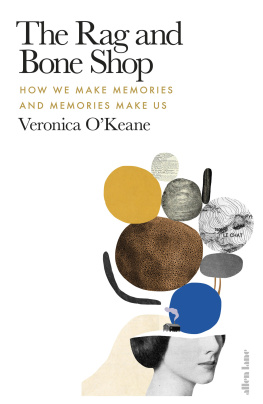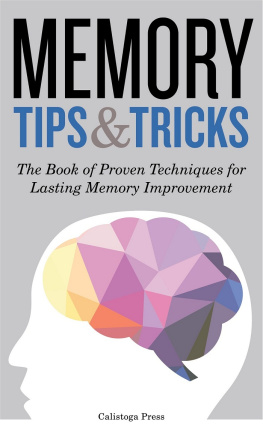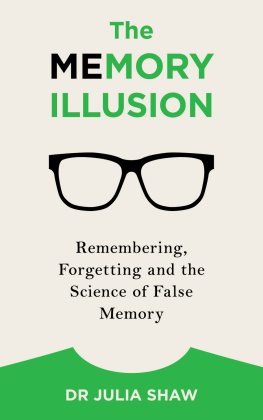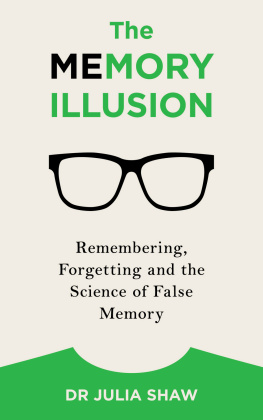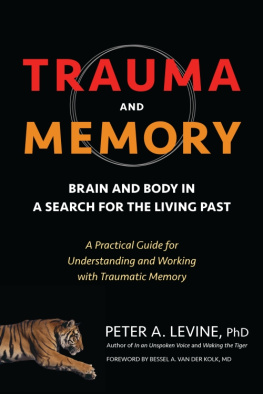For Esther and Sen
Veronica OKeane
THE RAG AND BONE SHOP
How We Make Memories and Memories Make Us

PENGUIN BOOKS
UK | USA | Canada | Ireland | Australia
New Zealand | India | South Africa
Penguin Books is part of the Penguin Random House group of companies whose addresses can be found at global.penguinrandomhouse.com.

First published by Allen Lane in 2021
Copyright Veronica OKeane, 2021
Grateful acknowledgement is given to the following for permission to reproduce copyrighted material: T. S. Eliot, extract from Four Quartets, reproduced by kind permission of Faber and Faber Ltd; Dylan Thomas, Fern Hill, from The Collected Poems of Dylan Thomas: The Centenary Edition, reproduced by kind permission of Weidenfeld and Nicolson, copyright The Dylan Thomas Trust.
The moral right of the author has been asserted
Cover illustration by Mathilde Aubier
ISBN: 978-0-141-99102-3
This ebook is copyright material and must not be copied, reproduced, transferred, distributed, leased, licensed or publicly performed or used in any way except as specifically permitted in writing by the publishers, as allowed under the terms and conditions under which it was purchased or as strictly permitted by applicable copyright law. Any unauthorized distribution or use of this text may be a direct infringement of the authors and publishers rights and those responsible may be liable in law accordingly.
Foreword
This heart within me I can feel, and I judge that it exists. This world I can touch and I likewise judge that it exists. There ends all my knowledge and the rest is construction.
Albert Camus, The Myth of Sysiphus (1955)
A small detail about the translation of the title of Prousts famous exploration of his childhood memory, la recherche du temps perdu, demonstrates much of what I will address in this book. Initially translated in 1954 as Remembrance of Things Past, the English title was changed in the 1992 edition to the more accurate In Search of Lost Time. The original translations remembrance of suggests a passive recall of memories from a hidden and fixed repository, while the later translations in search of suggests an active pursuit of a fluid past that is lost. Neuroscience almost caught up with Proust in the interval between the translations.
Notes
Literary bibliographical references and short explanatory notes are given in footnotes. Discursive notes are indicated by roman numerals, and can be found on .

Part One
HOW WE MAKE MEMORIES
1. Dawnings
There are events that occur in each of our lives that are experienced with a prescient sense that they will always be remembered. Occasionally this feeling is particularly intense and, while not epiphanic, carries with it a sense of having stumbled into a new level of awareness. This new awareness is pre-verbal, like the rattling of cups on saucers that is the only sign of subterranean shifts. The rattle that set me on the journey to understanding the real matter of memory occurred in London in the early 2000s. Looking back, the incident is like the introductory scene in a novel where every ingredient of the story to be told is laid out with a canny casual innocence that, if retrospectively analysed, is prophetic of the outcome. Ediths story set me on a journey of breaking down and reformulating my ideas about memory knowledge that had become automatic to me, but that somehow eluded the material essence of what it is to be a sensate, living human, with a memory sculpted by individual experience.
I met Edith in the Royal Bethlem Hospital, the oldest psychiatric hospital in the world and now part of the Maudsley Hospital of more contemporary fame. The Bethlem dates back to 1247, when it was called the Bedlam, until bedlam became a noun that indicated chaos and turmoil. The hospital was renamed in the early twentieth century as the Bethlem Royal. National treatment units were located in the 100-plus acres of horse chestnut and hazel tree grounds of the hospital. I worked for five years as the lead clinician in a National Perinatal Psychiatric Unit in the early 2000s, a unit that has so far been spared the decimation in NHS services that has since occurred. Women from all over the UK were transferred to us for specialist treatment of perinatal psychiatric illnesses illnesses that arise during pregnancy or during the postpartum period.
A badger family had setted in a tunnel in the ground close to the entrance to our unit. I often paused to look at the opening to their sett in its soft grassy mound on the off chance that the badger would, perhaps in a spontaneous moment of protective night watchmanship, pop its head out during daylight. I was commuting between London and Dublin during these years, and my two little ones in Dublin waited each week for news of sightings, but they had to do instead with pressed woodland flowers in spring and summer, and hazelnuts and conkers in late autumn. I loved my five years of working in the Bethlem, bringing women like Edith, who had been felled by the cruel illness of postpartum psychosis, back to their lives. Most of the women admitted to our unit had this rarely spoken-about psychosis, which occurs in about 1,400 women in the UK yearly. Edith was admitted to the Bethlem a few weeks following the birth of her baby. This is her story.
Edith had no history of psychiatric illness when she gave birth to her baby. Babys arrival was anticipated with joy. The pregnancy was healthy, and fetal scans were normal. Labour was uncomplicated and a healthy baby was delivered at term. In the days following Babys birth, Edith became emotionally distant, and seemed to become increasingly bewildered. She appeared to be distressed and preoccupied but would not communicate the cause of her distress. Her condition rapidly deteriorated and at the time of her admission she had stopped eating and was wandering aimlessly around her home day and night ignoring Baby and the rest of the world. Her family doctor assessed her at home and she was referred immediately to us for assessment and treatment. When I met Edith I noted that she was unusually slim in spite of having given birth less than two weeks previously. She had a closed expression and was more or less mute and unresponsive to our questions.
We frequently see this locked-in mien in individuals with psychotic experiences. In the case of women with postpartum psychosis, they usually hear voices that are not audible to others, may smell odours usually unpleasant that are not coming from the outside world and may feel sensations on their body that are not caused by anyone or anything that is visibly touching them. Such auditory, olfactory (smell), visual or somatic (touch or visceral) hallucinations are referred to as psychotic symptoms. The first principle that we need to establish is that what are called symptoms are real sensory experiences. Hearing a sound, a human voice, is a subjective experience, whether the voice originates in the outside world or is generated in the brain by pathological neuronal firing. The experience of hearing the voice is similar in both cases: the origin of the sensation is a separate consideration. If the experience is generated by pathological brain-firing, the voice hearer will look around to see whos talking, as one does, and may attribute the voices to whoever is present, or to hidden speakers. Commonly, those experiencing auditory hallucinations will look as if they are talking to themselves, whereas in their reality they are responding to voices that are as audible and real to them as the voice of a living person.
Next page
